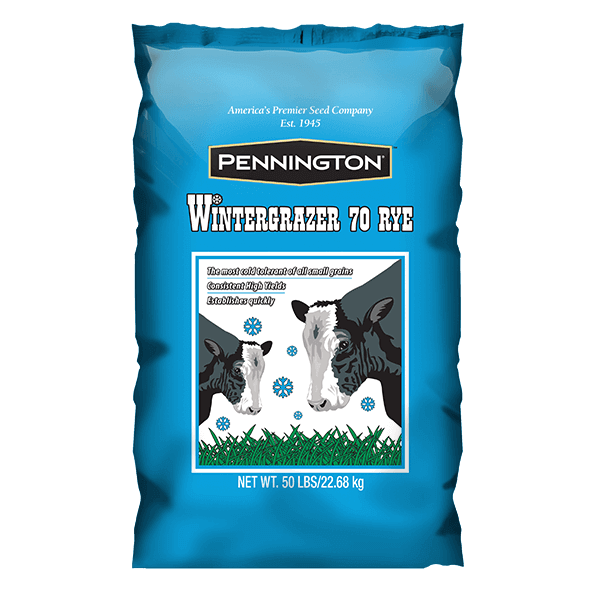
Wintergrazer 70 Cereal Rye Forage
Under favorable growing conditions, Wintergrazer 70 cereal rye establishes quickly to provide grazing within 6-8 weeks after planting. It grows at lower winter temperatures than other cool season grasses, thereby extending the grazing season. In southern areas of adaptation, it can provide grazing in December, January and February when other grasses are dormant. As a cover crop, rye is the best cool season cereal grain cover for scavenging unused soil nitrogen; taking up as much as 100 lbs. of nitrogen per acre and holding it for subsequent use by a warm season crop. When used in a conservation tillage system, Wintergrazer 70 rye protects the soil surface from rainfall impact, reduces surface runoff erosion, increases water infiltration rates, builds soil organic matter and improves soil tilth.
USES: For late fall and winter pastures, hay, cover crop and green chop. Can be overseeded into warm season pastures (bermuda, bahia, etc.) alone or in mixtures with clover and/or annual ryegrass to extend the grazing season. Excellent for wildlife food plots especially when mixed with Durana.
Wintergrazer Forage Production Tech Sheet
Wintergrazer Cover Crop Production Tech Sheet
Passerel Plus and Wintergrazer 70 FAQ
Sizes:
Planting
Seeding Rate: 90-120 lbs/acre drilled or 125-150 lbs/acre broadcast
Date: Northern region: August 15 ? October 15; Southern region: September 15 ? November 15
Depth: 3/4" to 1.5"
Fertilization: Soil testing is highly recommended. Lime soil to a pH between 6.0 and 7.0. Apply 40-60 lbs./A. starter nitrogen and follow soil test recommendations for phosphorus and potassium. Method: Drill seed into a well-prepared and firm seedbed or use a no-till drill to overseed it into closely clipped or grazed warm season perennial pastures. Seed may also be broadcast over a prepared seedbed and lightly disked in. Planting too deep or too shallow can result in poor stand emergence. Can be mixed with ryegrass and/or clover. If planted in a mixture with ryegrass and/or annual clover, do not plant deeper than 1/2".
Management
Top-grazing rye in late fall and early winter and rotationally grazing it in early spring offer optimum growth and utilization of forage. Grazing can begin in the fall when forage growth reaches 6-8 inches in height and roots are well anchored. Remove livestock when 4 inches of growth remains. Note: Grazing on wet, poorly drained soils can result in plant damage and reduced spring growth. Rye responds well to high rates of nitrogen fertilizer. Apply 60 ? 80 lbs./A nitrogen as a side-dress application in late winter. Rotational or strip grazing greatly improves utilization efficiency of rye forage particularly during spring flush. For top quality hay or silage, harvest when Wintergrazer 70 is in the flag leaf stage of growth. Cautionary Note: Provide animal access to high magnesium mineral to reduce incidence of grass tetany.
For Cover Crop Use
Planting
Seeding Rate: 30-60 lbs./A in mixes; 60-120 lbs/acre planted alone
Date: Northern region: August 15 ? October 15 Southern region: September 15 ? November 15
Depth: ? -1? inches
Fertilization: Soil testing is highly recommended. Lime soil to a pH of 6.0-6.5 and follow soil test recommendations for phosphorus and potassium. If WG 70 is to be used as a cover crop only, an optional application of 25-30 lbs./A starter nitrogen will provide faster soil cover and increase fall bio-mass production.
Method: Drill seed into a well-prepared and firm seedbed or use a no-till drill to overseed it into harvested crop stubble taking care to place the seed at the proper depth in the soil. Seed may also be broadcast over a prepared seedbed and lightly disked in. Planting too deep or too shallow can result in poor stand emergence. If planted in a mixture with ryegrass and/or annual clover, do not plant deeper than 1/2".
Management
If used dual-purpose for cover and grazing/hay, apply 40-60 lbs./A. starter nitrogen. If additional forage is needed, apply another 40-60 lbs./A nitrogen as a side-dress application in late winter. Begin fall grazing when forage growth reaches 6-8 inches in height and roots are well anchored. Remove livestock when 4 inches of growth remains. Note: Grazing on wet, soggy soils can result in plant damage and reduced protective plant cover. For top quality hay or silage, harvest when Wintergrazer 70 is in the flag leaf stage of growth. Cautionary Note: If grazed, provide animal access to high magnesium mineral to reduce incidence of grass tetany. Special Consideration: Grazing forage growth below a height of 6-8 inches can reduce the effectiveness of the rye cover for certain cover crop benefits including suppressing weeds, building soil organic matter and improving soil tilth.
Termination
In conventional tillage systems, terminate by disking or moldboard plowing 1-2 weeks ahead of planting the summer crop. For no-till systems, apply a burn-down herbicide such as glyphosate or paraquat one to three weeks before or immediately after seeding (prior to crop emergence) the summer crop. Best results for chemical burndown are obtained when rye is actively growing and daytime ambient temperatures reach 55? F or higher. Refer to the product label for usage rate, spray volume, additives, nozzle selection and rain fastness. (Consult with the local university extension office or other area experts for tank mix options.) Mowing or rolling can also be effective, but should be done after the rye has initiated seed head development to help prevent re-growth.
